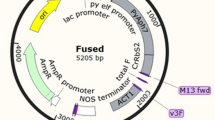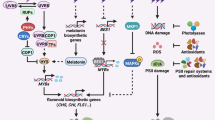Abstract
Recently we reported that Catalase-1 (CAT-1) played an important role in protecting conidial viability in Neurospora crassa, and interacted with a light signal transducer, nucleoside diphosphate kinase-1 (NDK-1). To disclose the functional interaction between CAT-1 and NDK-1 at the genetic level, we created CAT-1 and NDK-1 double mutants, cat-1;ndk-1-1 and cat-1;ndk-1-2, by crossing single mutants of cat-1 RIP and ndk-1 P72H previously isolated in our laboratory. The double mutant strains grew normally, but showed increased CAT-2 activity. In cat-1 RIP, NDK activity was increased when dCDP was used as a substrate. ndk-1 P72H, cat-1;ndk-1-1, and cat-1;ndk-1-2 were more sensitive to riboflavin than the wild type and cat-1 RIP under strong light (100 μE m−2 s−1). The pull-down experiment suggests that His-tagged NDK-1 is bound to [32P]NADH. However, his-tagged NDK-1P72H was not bound to [32P]NADH. The double mutants showed much lower conidial viability and lost all conidial germination ability much more rapidly than cat-1 RIP, when they were cultured under continuous light for more than 2 weeks. These results indicate that the interaction of CAT-1 with NDK-1 plays an important role in supporting the survival of conidia under oxidative and light-induced stress including singlet oxygen, and confirm our former conclusion that reactive oxygen species play an important role in light signal transduction via NDK-1 at the genetic level.





Similar content being viewed by others
References
Bernard MA, Ray NB, Olcott MC, Hendricks SP, Mathews CK (2000) Metabolic functions of microbial nucleoside diphosphate kinases. J Bioenerg Biomembr 32:259–267
Cuello F, Schulze RA, Heemeyer F, Meyer HE, Lutz S, Jakobs KH, Niroomand F, Wieland T (2003) Activation of heterotrimeric G proteins by a highly energy phosphate transfer via nucleoside diphosphate kinase (NDPK) B and Gβ subunits. J Biol Chem 278:7220–7226
Davis RH, De Serres FJ (1970) Genetic and microbiological research techniques for Neurospora crassa. Methods Enzymol 71:79–143
Degli-Innocenti F, Russo VE (1984) Isolation of new white collar mutants of Neurospora crassa and studies on their behaviour in the blue-light-induced formation of protoperithecia. J Bacteriol 159:757–761
Diaz A, Horjales E, Rudino-Pinera E, Arreola R, Hansberg W (2004) Unusual Cys–Tyr covalent bond in a large catalase. J Mol Biol 342:971–985
Diaz A, Munoz-Clares RA, Rangel P, Valdes VJ, Hansberg W (2005) Functional and structural analysis of catalase oxidized by singlet oxygen. Biochimie 87:205–214
Dolamns DEJGJ, Fukumura D, Jain RK (2003) Photodynamic therapy for cancer. Nat Rev 1:380–387
Feldman JF (1982) Genetic approaches to circadian clocks. Annu Rev Plant Physiol 33:583–608
Fukamatsu Y, Yabe N, Hasunuma K (2003) Arabidopsis NDK1 is a component of ROS signaling by interacting with three catalases. Plant Cell Physiol 44:982–989
Harding RW, Turner RV (1981) Photoregulation of the carotenoid biosynthetic pathways in albino and white collar mutants of Neurospora crassa. Plant Physiol 68:745–749
Harding RW, Melles S (1984) Genetic analysis of the phototropism of Neurospora crassa perithecial beaks using white collar and albino mutants. Plant Physiol 72:996–1000
Hillar A, Nicholls TP, Switala J, Loewen PC (1994) NADPH binding and control of catalase compound II formation: comparison of bovine, yeast, and Escherichia coli enzymes. Biochem J 300:531–539
Iigusa H, Yoshida Y, Hasunuma K (2005) Oxygen and hydrogen peroxide enhance light-induced carotenoid synthesis in Neurospora crassa. FEBS Lett 579:4012–4016
Kirkman HN, Rolfo M, Ferraris AM, Gaetan GF (1999) Mechanisms of protection of catalase by NADPH. J Biol Chem 274:13908–13914
Lee B, Yoshida Y, Hasunuma K (2006) Photomorphogenetic characteristics are severely affected in nucleoside diphosphate kinase-1 (ndk-1)-disrupted mutants in Neurospora crassa. Mol Genet Genomics 275:9–17
Lledias F, Rangel P, Hansberg W (1998) Oxidation of catalase by singlet oxygen. J Biol Chem 273:10630–10637
Lledias F, Rangel P, Hansberg W (1999) Singlet oxygen is part of a hyperoxidant state generated during spore germination. Free Radic Biol Med 26:1396–1404
Massey V (2000) The chemical and biological versatility of riboflavin. Biochem Soc Trans 28:283–296
Michan S, Lledias F, Baldwin JD, Natvig DO, Hansberg W (2002) Regulation and oxidation of two large monofunctional catalases. Free Radic Biol Med 33:521–532
Moon H, Lee B, Choi G, Shin D, Prasad DT, Lee O, Kwak SS, Kim DH, Nam J, Bahk J, Hong JC, Lee SY, Cho MJ, Lim CO, Yun DJ (2003) NDP kinase 2 interacts with two oxidative stress-activated MAPKs to regulate cellular redox state and enhances multiple stress tolerance in transgenic plants. Proc Natl Acad Sci USA 100:358–363
Muñoz-Dorado J, Inouye S, Inouye M (1990) Nucleoside diphosphate kinase from Myxococcus xanthus. II. Biochemical characterization. J Biol Chem 265:2707–2712
Oda K, Hasunuma K (1997) Genetic analysis of signal transduction through light-induced protein phosphorylation in Neurospora crassa. Mol Gen Genet 256:593–601
Ogura Y, Yoshida Y, Ichimura K, Aoyagi C, Yabe N, Hasunuma K (1999) Isolation and characterization of Neurospora crassa nucleoside diphosphate kinase NDK-1. Eur J Biochem 266:709–714
Ogura Y, Yoshida Y, Yabe N, Hasunuma K (2001) A point mutation in nucleoside diphosphate kinase results in a deficient light response for perithecial polarity in Neurospora crassa. J Biol Chem 276:21228–21234
Omata Y, Lewis JB, Rotenberg S, Lockwood PE, Messer RL, Noda M, Hsu SD, Sano H, Wataha JC (2006) Intra- and extracellular reactive oxygen species generated by blue light. J Biomed Mater Res A 77(3):470–477
Sargent ML, Briggs WR (1967) The effects of blue light on a circadian rhythm of conidiation in Neurospora. Plant Physiol 42:1504–1510
Schliebs W, Würtz C, Kunau W-H, Veenhuis M, Rottensteiner H (2006) A eukaryote without catalase-containing microbodies: Neurospora crassa exhibits a unique cellular distribution of its four catalases. Eukaryot cell 5(9):1490–1052
Schmit JC, Brody S (1976) Biochemical genetics of Neurospora crassa conidial germination. Bacteriol Rev 40:1–41
Wang N, Yoshida Y, Hasunuma K (2007) Loss of Catalase-1 (CAT-1) results in decreased conidial viability enhanced by exposure to light in Neurospora crassa. Mol Genet Genomics 277:13–22
Yoshida Y, Hasunuma K (2004) Reactive oxygen species affect photo-morphogenesis in Neurospora crassa. J Biol Chem 279:6986–6993
Yoshida Y, Hasunuma K (2006) Light-dependent subcellular localization of nucleoside phosphate kinase-1 in Neurospora crassa. FEMS Microbiol Lett 261:64–68
Yoshida Y, Ogura Y, Hasunuma K (2006) Interaction of nucleoside diphosphate kinase and catalases for stress and light responses in Neurospora crassa. FEBS Lett 580(13):3282–3286
Acknowledgments
This study was supported by a grant-in-aid from the Japan Society for the Promotion of Science, the Kihara Memorial Yokohama Foundation for the Advancement of Life Science, the Mishima Kaiun Memorial Foundation, the Yamada Science Foundation, and co-operative research support from Nissan Motor Co., Ltd.
Author information
Authors and Affiliations
Corresponding author
Additional information
Communicated by J. Perez-Martin.
Electronic supplementary material
Below is the link to the electronic supplementary material.
Rights and permissions
About this article
Cite this article
Wang, N., Yoshida, Y. & Hasunuma, K. Catalase-1 (CAT-1) and nucleoside diphosphate kinase-1 (NDK-1) play an important role in protecting conidial viability under light stress in Neurospora crassa . Mol Genet Genomics 278, 235–242 (2007). https://doi.org/10.1007/s00438-007-0244-y
Received:
Accepted:
Published:
Issue Date:
DOI: https://doi.org/10.1007/s00438-007-0244-y




